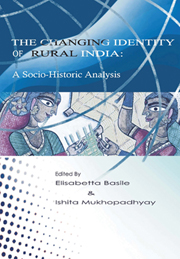Book contents
- Frontmatter
- Contents
- Acronyms and Abbreviations
- About the Authors
- INTRODUCTION
- PART 1 INDIAN RURAL TRANSFORMATIONS
- PART 2 INEQUALITY IN RURAL INDIA
- Social Capital and Poverty Reduction Strategies: The Case of Rural India
- An Overview of Indian Microfinance
- Income-based Estimates vs Consumption-based Estimates of Poverty: Evidence from Rural Tamil Nadu after Liberalization
- Occupational Diversification of the Rural Workers: Some Results from Field Surveys in West Bengal
- Literacy and Externalities in Human Development
- PART 3 SOCIAL MOVEMENTS AND IDENTITIES
- Appendix 1 Socio-Economic Indicators of Rural India
Income-based Estimates vs Consumption-based Estimates of Poverty: Evidence from Rural Tamil Nadu after Liberalization
from PART 2 - INEQUALITY IN RURAL INDIA
Published online by Cambridge University Press: 05 March 2012
- Frontmatter
- Contents
- Acronyms and Abbreviations
- About the Authors
- INTRODUCTION
- PART 1 INDIAN RURAL TRANSFORMATIONS
- PART 2 INEQUALITY IN RURAL INDIA
- Social Capital and Poverty Reduction Strategies: The Case of Rural India
- An Overview of Indian Microfinance
- Income-based Estimates vs Consumption-based Estimates of Poverty: Evidence from Rural Tamil Nadu after Liberalization
- Occupational Diversification of the Rural Workers: Some Results from Field Surveys in West Bengal
- Literacy and Externalities in Human Development
- PART 3 SOCIAL MOVEMENTS AND IDENTITIES
- Appendix 1 Socio-Economic Indicators of Rural India
Summary
India adopted Structural Adjustment Programmes (SAPs) in 1991; since then economic growth rocketed and, according to the Planning Commission and the World Bank, poverty indicators drastically declined. This ‘official’ decline contradicts the figures on agricultural crisis, hunger, food consumption and undernutrition, which are undoubtedly worsening. This paper gives an explanation for this apparent contradiction through an analysis of poverty figures and an assessment of the related methodologies. The aim of this paper is to show why consumption-based measurements are not fully reliable to measure poverty in India.
This paper is divided into five sections. The first section focuses on the decline of official poverty figures in the world and India in particular as a consequence of liberalization. The second section illustrates India's agricultural crisis and its dramatic consequences for the country's food security. The third section explains the technical errors of poverty measurements while the fourth section analyses the theoretical shortcomings below these methodologies. Finally the fifth section, showing the results of field work in three villages of rural Tamil Nadu, demonstrates that consumption-based methodologies are inaccurate to measure the real trend of poverty.
THE DECLINE OF POVERTY
The Apparent Decline of Poverty in a Globalized Economy
Since 1990, poverty – measured as the percentage of people living in families which earn or consume less than $1 per day – has drastically declined. Between 1990 and 2004, the poverty rate in developing countries fell from 31.6 per cent to 19.2 per cent, while the total number of people living in poverty fell from 1.25 billion in 1990 to 980 million in 2004 (UN, 2007).
- Type
- Chapter
- Information
- The Changing Identity of Rural IndiaA Sociohistoric Analysis, pp. 113 - 149Publisher: Anthem PressPrint publication year: 2009



